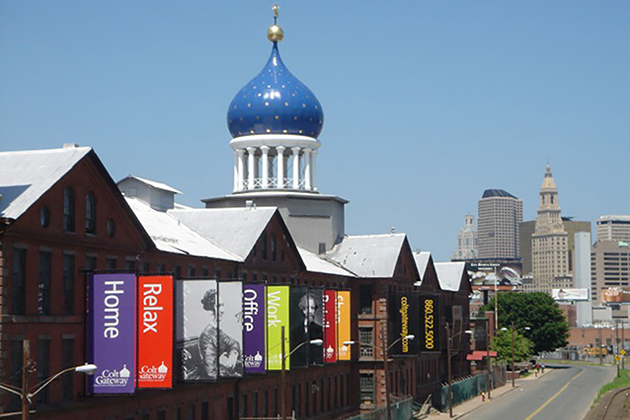
Gun manufacturer Colt Defense LLC has filed for Chapter 11 bankruptcy, a process that will allow for an accelerated sale of Colt’s business operations in the U.S. and Canada. The Hartford, Conn.-based manufacturer, which created the iconic revolver whose bullets were loaded into a revolving cylinder that became known as “the gun that won the West,” has been a major producer of firearms since the early 1800s. How did Colt get to this point and what does the future hold? UConn Today asked economic historian Fred Carstensen, a professor of finance and economics in the School of Business, and director of the Connecticut Center for Economic Analysis. His comments have been edited for length.
What will be the economic impact in Connecticut both in the short and long term?
In the short run, the economic impact will be slight, as Colt will continue its current operations, has arranged sufficient credit to cover current costs, and said it will not lay off any employees. Chapter 11 will also allow Colt to impose a restructuring on its creditors, who had refused to agree voluntarily to a pre-arranged bankruptcy. If Colt is having difficulty paying its bond holders, it wants them to restructure the debt or accept shares instead. In tough times, shareholders don’t get dividends; bondholders must always be paid.
The filing of Chapter 11 bankruptcy papers by Colt focuses attention on a sector of an industry that Connecticut has had mixed feelings about since the early 19th century, according to Walter Woodward, associate professor of history and State Historian.
“While our standard of living is, to a significant extent, derived from the military industrial complex, Connecticans have long exhibited antipathy toward war itself,” Woodward says of the state’s economic reliance on manufacturers that support the defense industry.
The firearms industry in Connecticut began in 1798 when Eli Whitney, best known for inventing the cotton gin, was awarded a government contract to make rifles with interchangeable parts, Woodward says.
Whitney was unable to fully deliver on the idea, but others did. The firearms industry gained traction in 1810 with the first pistol factory in the nation established in Middletown by Oliver Bidwell. Two years later, another pistol maker in Middletown also won a large contract to supply guns to the U.S. military.
Those two factories helped Middletown become a major American arms supplier during the War of 1812, the two-and-a-half year struggle between the young nation and Great Britain, even while the war was fiercely opposed by the state’s residents.
The Connecticut River Valley thrived as the gun industry grew. Based on the success of his patented revolver, Samuel Colt opened his firearms factory in Hartford in 1855, and using the idea of machine-tooled interchangeable parts, his guns became world famous.
“The explosion in industrial output and technology in the second half of the 19th century made Connecticut an American industrial giant. It inspired Mark Twain to write his novel A Connecticut Yankee in King Arthur’s Court, in which a 19th-century man finds himself in medieval England and uses his knowledge of technology to help Arthur create Camelot.
“The early boost the state got from the firearms industry laid the foundation for this manufacturing base,” says Woodward. According to the Defense Technology Initiative, Connecticut firms were awarded contracts valued at more than $22.4 billion in 2012 in areas such as ship building and repairing, aircraft manufacturing, and aircraft engine and parts manufacturing.
“Whether we like guns or not,” Woodward adds, “Connecticut owes the firearms industry a lot.”
For the long term, Colt has already significantly cut back its manufacturing, because it lost a critical U.S. government contract for M4 rifles in 2013, and since then has been confined to the non-military market. Comments by former Colt employees on media websites claim that the company is not delivering a truly competitive product; that other U.S. firearm producers have better guns with more features and lower prices. These critics also charge that Colt is still using very old machine tools and that recent owners have been unwilling to invest in the business. I can’t evaluate the accuracy of these claims, but they underscore a common challenge in manufacturing: competition is relentless.
Will there be ripple effects? What ancillary businesses might be affected by Colt’s decision?
At this point Colt is not planning to downsize further; it already did so after the loss of the M4 contract. So for both employment and in-state purchasing, there has already been some impact. Insofar as Colt’s suppliers are competitive in supplying components to other manufacturers (the company that won the M4 contract, for example), the impact may not be severe. However, it is often the case that when a company like Colt sells off assets or restructures debt, the owners are looking to maximize the short-term returns. It’s not uncommon that it makes better business sense to extract those profits and let the business run down. This is very unfortunate from the perspective of employees, but market dynamics don’t always generate innovation, job growth, and economic expansion. The great challenge for public policy is to frame competitive markets in such a way that, in seeking private benefit, investors and owners will also deliver those socially beneficial outcomes that are the ultimate justification for those competitive markets.
What does filing for bankruptcy really mean today? Colt says Chapter 11 will allow “a significantly lower debt burden,” but that they will continue normal business operations. Bankruptcy used to mean the end of the company.
There are two kinds of bankruptcy. Chapter 11 allows a company, under court supervision, to renegotiate its debts and obligations, including – potentially – union contracts. Chapter 11 is designed to sustain companies as “going concerns,” even selling off some of their assets as a means of preserving the company. Chapter 7 bankruptcy is used for liquidation of a business that is so far under water, or faces such stiff competitive winds, that there is little or no prospect of recovery. Under Chapter 7, the business is closed and all its assets auctioned off; the proceeds are paid to creditors in order of their standing. Typically shareholders, who stand last in line, will get little or nothing.
What would it mean if this iconic American firearms manufacturer were sold to a foreign entity?
A foreign buyer might actually be a good development if it meant an owner willing to invest in state-of-the-art production technology and improved design of the Colt guns. Critics have charged that Colt, despite its extraordinary pedigree, is falling behind in design and quality. The critical challenge is thus to make the investment necessary that will allow the company to once again make products that are high quality and price-competitive.
Do Colt’s financial difficulties point to a larger trend affecting weapons manufacturers worldwide?
I doubt it. This is a horribly unstable world with, perhaps inevitably, huge demand for conventional firearms, especially those that can be used in military conflict. Moreover, warfare – whether guerrilla or conventional – is enormously destructive, of men, machines, buildings, and firearms. The more military conflict there is, the more weapons get broken or ruined, and thus the higher demand there is for replacements. Sadly, I suspect that global demand for firearms has rarely been more promising.



